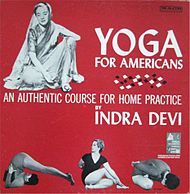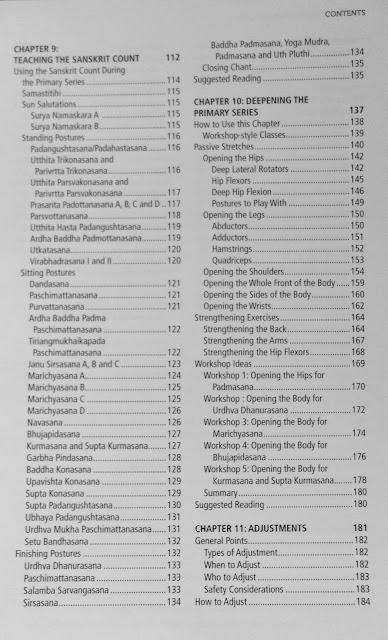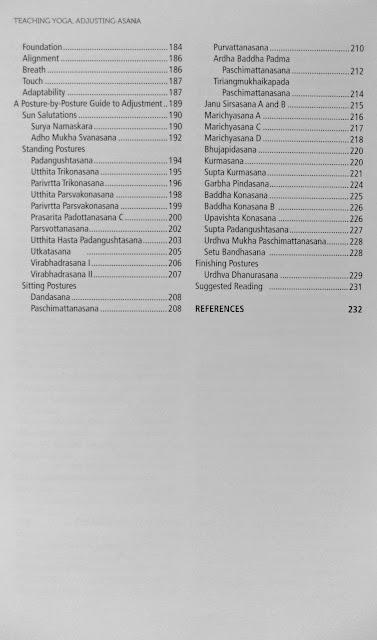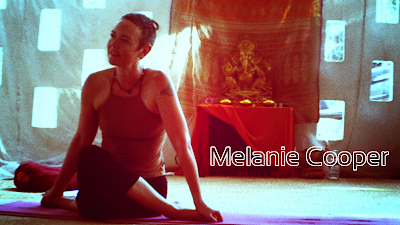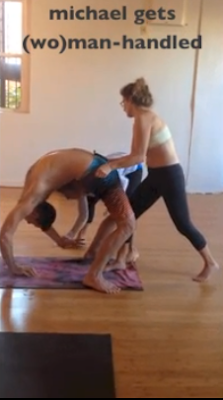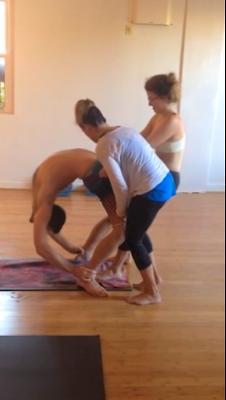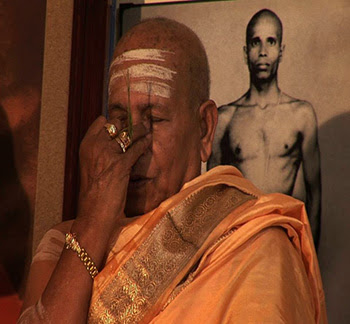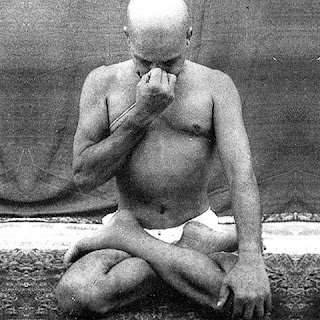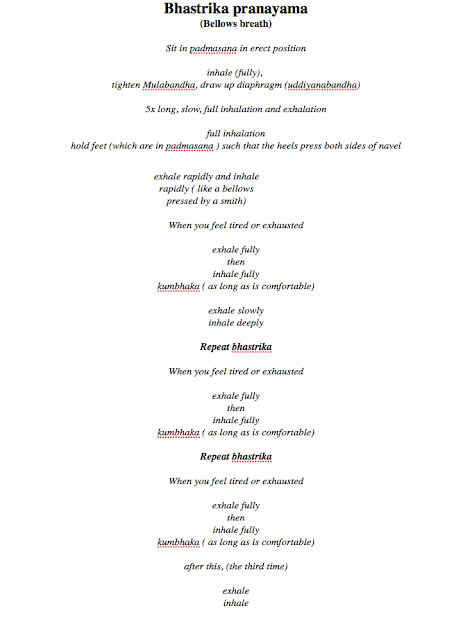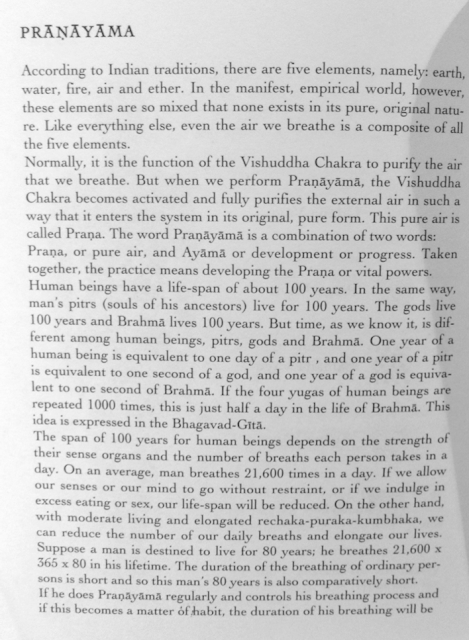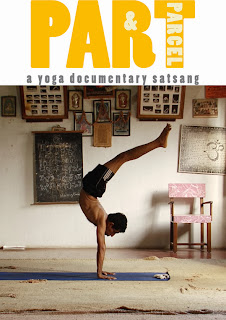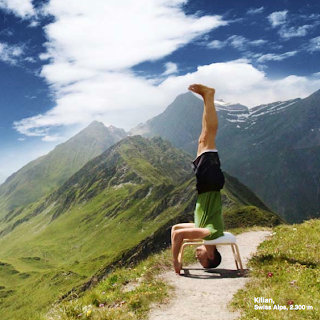| Image may be NSFW. Clik here to view.  |
| Indra Devi teaching Marilyn Monroe |
I just came across the picture above of Indra Devi teaching Marilyn Monroe Yoga ( thank you Agnieszka for posting it this morning), I'd seen the Marilyn yoga pictures before (see the Eric Shaw link below) and knew of course that Indra Devi had taught in Hollywood, Greta Garbo, Gloria Swenson etc. but hadn't come across direct evidence of her actually teaching Marilyn. Nice picture.
Eric Shaw mentions that the first pictures we have of Marilyn Monroe practicing yoga are from 1948, the one above seems to have been from Nov 1960.
| Image may be NSFW. Clik here to view. 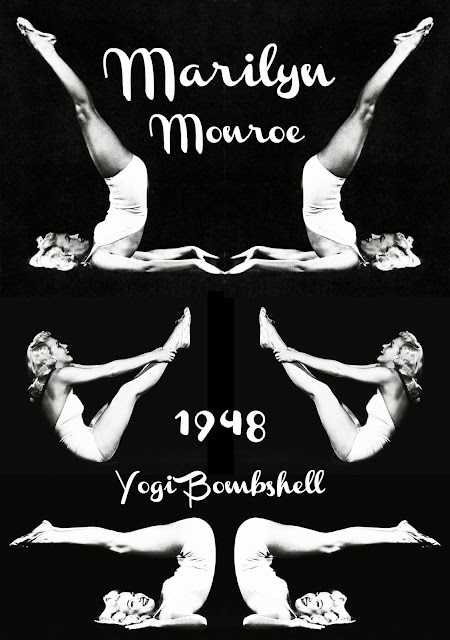 |
| See the complete Marilyn Yoga photo's at Eric Shaw's website |
"The first evidence of her practice appears near the time of her first acting contract (’46). Of the 21 pictures below, the 5 stark black-and-white ones in the same white outfit are from a set of promotional photos sent out in 1948.
Orienting these pictures in local yoga history, they appeared the same year Krishnamacharya‘s student, Indra Devi open a yoga studio on LA’s Sunset Boulevard. (She arrived in ’47 after a brief trip to Shanghai. Devi had been in India in ’46, teaching yoga and writing her first book).
Devi soon had Olivia de Haviland, Ruth St. Denis, Gloria Swanson, Elizabeth Arden, Greta Garbo and other famous players in LA’s movie-making community as devotees". Eric Shaw
*
I hunted around my blog for a link to an earlier post on Indra Devi but only came across the draft below that I'd intended to put up for her birthday.
Better late than never.
Here's indra Devi in a picture taken on krishnamacharya's 100th Birthday Celebration and below an account of her early years in Mysore being taught by Krishnamacharya in 1937.
Clik here to view.

"One time a friend staying with the couple suddenly started experiencing heart trouble. Indra recalled how Indian yoga masters demonstrated their healing methods and concentrated all her thoughts on curing her ill friend. He recovered, but the following day she herself experienced chest pains and had to stay in bed. A local doctor diagnosed her with heart failure, but the prescribed treatment did not help. European doctors proved helpless, too. She thus spent the subsequent four years rocking back and forth between getting better and worse.
A friend of hers, who himself studied yoga for many years, said: “You applied a yoga method. Why won’t you discuss your illness with yogis? This would be logical.”
Indra heeded his advice and came to the legendary guru Sri Tirumalai Krishnamacharya. She decided to take a course in yoga to recover and adopt a healthy lifestyle, but the guru looked her up and down with an ironic glance and said that yoga was for Indian men only. Indeed, only young Kshatriyas studied at the Mysore Yoga Shala in 1937.
“It would be impossible for me to take on a woman, especially a foreign one. It cannot be done,” the guru insisted. “He could work miracles, such as stop his heart and turn the lights on and off at a distance. But he could not get rid of me,” Indra Devi said. Yet, Krishnamacharya did relent after Maharaja of Mysore interfered by putting in a word for Indra. Indra was admitted to the yoga shale, but Krishnamacharya was not going to take it easy on her. The diplomat’s wife had to comply with strict discipline and observe a strict diet, avoiding any “dead” products, including not just meat but also white sugar, flour, rice, and preserves. Root vegetables, such as potato, onion and carrot, were also excluded. She was allowed to eat only whatever the sun shined on. The students got up before dawn, and they had to go to bed before 9 at night. It was also forbidden to use a stove to warm oneself up. “I have no special classes for women,” Krishnamacharya told her right off the bat; she had to keep up with the male students.
Things were very difficult for Indra at first, but, little by little, she got used to everything, losing weight and completely recovering from her strange disease. Appreciating her zeal, Krishnamacharya began working with her individually.
“He said I was ready to move on to the next stage of training. The next day he asked me to come earlier and locked the door. He sat on the floor and began to show me special secret exercises to control my breathing and told me to write everything down,” Indra Devi recalled.
In 1938 she became the first foreign woman among dedicated yogis. When Krishnamacharya learned that her husband was to be transferred to China, he called her again: “You are now leaving us, you will teach yoga. You can do it, and you will do it.”
Indra thought this was unbelievable: as a newly dedicated yogi, she could not grasp that she, too, would be a guru one day. In India, however, people don’t argue with their teachers. On a ship to China she realised that, for the first time ever she no longer wants to dance, wear jewellery and expensive clothes. It was then that she put on a light sari, which became the only clothing she recognised hereafter".
from Indra Devi's Legacy
"Movements in yoga are harmonious, slow, soft, plastic, relaxed, always conscious, and require a permanent and active mental participation. The whole work rests on the dialectic tension-relaxation. It's important to stimulate, turn elastic, tonify, to make oneself conscious of limbs, superficial and deep muscles, joints, and spine, achieving a gradual and progressive limb decontraction, loosening and relaxation.
"Nonviolence is one of the keys of yoga, and we should begin it by ourselves. Learning to recognize and respect our own peculiar rhythm and working on that base is essential".
*
Below from Yoga Journal
Krishnamacharya's legacy By Fernando Pagés Ruiz ( the section on Indra Devi )
'Even as Krishnamacharya taught the young men and boys at the Mysore Palace, his public demonstrations attracted a more diverse audience. He enjoyed the challenge of presenting yoga to people of different backgrounds. On the frequent tours he called "propaganda trips," he introduced yoga to British soldiers, Muslim maharajas, and Indians of all religious beliefs. Krishnamacharya stressed that yoga could serve any creed and adjusted his approach to respect each student's faith. But while he bridged cultural, religious, and class differences, Krishnamacharya's attitude toward women remained patriarchal. Fate, however, played a trick on him: The first student to bring his yoga onto the world stage applied for instruction in a sari. And she was a Westerner to boot!
The woman, who became known as Indra Devi (she was born Zhenia Labunskaia, in pre-Soviet Latvia), was a friend of the Mysore royal family. After seeing one of Krishnamacharya's demonstrations, she asked for instruction. At first, Krishnamacharya refused to teach her. He told her that his school accepted neither foreigners nor women. But Devi persisted, persuading the Maharaja to prevail on his Brahmin. Reluctantly, Krishnamacharya started her lessons, subjecting her to strict dietary guidelines and a difficult schedule aimed at breaking her resolve. She met every challenge Krishnamacharya imposed, eventually becoming his good friend as well as an exemplary pupil.
After a year-long apprenticeship, Krishnamacharya instructed Devi to become a yoga teacher. He asked her to bring a notebook, then spent several days dictating lessons on yoga instruction, diet, and pranayama. Drawing from this teaching, Devi eventually wrote the first best-selling book on hatha yoga, Forever Young, Forever Healthy. Over the years after her studies with Krishnamacharya, Devi founded the first school of yoga in Shanghai, China, where Madame Chiang Kai-Shek became her student. Eventually, by convincing Soviet leaders that yoga was not a religion, she even opened the doors to yoga in the Soviet Union, where it had been illegal. In 1947 she moved to the United States. Living in Hollywood, she became known as the "First Lady of Yoga," attracting celebrity students like Marilyn Monroe, Elizabeth Arden, Greta Garbo, and Gloria Swanson. Thanks to Devi, Krishnamacharya's yoga enjoyed its first international vogue.
Although she studied with Krishnamacharya during the Mysore period, the yoga Indra Devi came to teach bears little resemblance to Jois's Ashtanga Vinyasa. Foreshadowing the highly individualized yoga he would further develop in later years, Krishnamacharya taught Devi in a gentler fashion, accommodating but challenging her physical limitations.
Devi retained this gentle tone in her teaching. Though her style didn't employ vinyasa, she used Krishnamacharya's principles of sequencing so that her classes expressed a deliberate journey, beginning with standing postures, progressing toward a central asana followed by complementary poses, then concluding with relaxation. As with Jois, Krishnamacharya taught her to combine pranayama and asana. Students in her lineage still perform each posture with prescribed breathing techniques.
Devi added a devotional aspect to her work, which she calls Sai Yoga. The main pose of each class includes an invocation, so that the fulcrum of each practice involves a meditation in the form of an ecumenical prayer. Although she developed this concept on her own, it may have been present in embryonic form in the teachings she received from Krishnamacharya. In his later life, Krishnamacharya also recommended devotional chanting within asana practice'.
*
And in Indra Devi's own words, written in 1966, an account of her year in Mysore with Krishnamacharya from Yoga the technique of Health and Happiness ( a huge thank you yet again to my friend Ryan Leier for passing this text along to me)
And in Indra Devi's own words, written in 1966, an account of her year in Mysore with Krishnamacharya from Yoga the technique of Health and Happiness ( a huge thank you yet again to my friend Ryan Leier for passing this text along to me)
Chapter four is Indra Devi outlining the origins of Yoga
*
